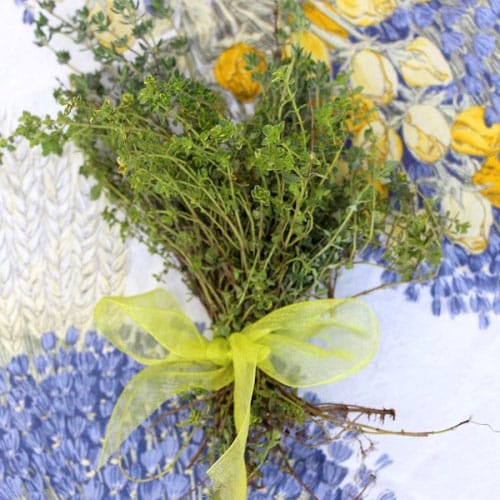Here at Cherry Valley, we grow dozens of different types of herbs, but one of our favorites is thyme. While you might think that there's only one type of thyme, that isn't the case. There are dozens of different varieties of thyme, each with their own unique appearance and flavor.

Some thyme varieties are better for culinary purposes, while others make better ornamentals. A few types of thyme even create a beautiful, low-growing ground cover. Today, we'd like to introduce you to some of the amazing thymes we grow here at the farm and fill you in on how you can grow and harvest them in your own garden.
Varieties of Thyme
Leafing through the seed catalogs each winter, we always get excited about all the possibilities when it comes to the offered selections of thyme. We tend to add too many to our seed list and then have to pare our selections down to the varieties we think will best suit our customers' gardens. Here are a few of our favorites:
The Citrus-scented thymes: We grow three different citrus thymes - lime, lemon, and orange. Each has a subtly different flavor and appearance. Lime thyme is a light chartreuse green with a distinct scent and flavor of lime. Lemon thyme has green foliage edged in white. When the foliage is crushed, the scent of lemon is unmistakable. Orange thyme has small, green leaves and smells like a freshly-peeled orange. We love adding all three of these citrus thyme to our herbal tea blends.

German Winter: German winter thyme offers an excellent, classic culinary thyme flavor. It has small green leaves but isn't as hardy as some other types of thyme.
Transparent Yellow: This variety of thyme has chartreuse foliage and is excellent for both culinary and ornamental uses. It creeps around along the ground and has prolific spring growth.
Silver Edge: A beautiful variety, this thyme selection is primarily ornamental, though it's certainly edible. The small, green leaves are edged in white, making it a real beauty in the garden.
French: With true classic thyme taste, French thyme has long, easy-to-harvest stems that are intensely aromatic. The leaves are solid green, and it's among the easiest thymes to grow.

Woolly: A terrific thyme for adding unique texture to the garden, woolly thyme stays very low to the grown and spreads out into a nice carpet. The foliage is covered in tiny hairs, giving the plant its common name. Woolly thyme makes a great ground cover or you can use it as a "crack stuffer," growing it between stepping stones or patio pavers.
Foxley: This unique time is variegated cream and white and has fairly broad leaves for a thyme. It's both edible and ornamental, and the flowers are more purple than some other varieties. Its texture is very soft.
How to Grow Thyme
Thyme has been cultivated since the time of the ancient Egyptians and has been used for culinary, medicinal, and spiritual purposes for thousands of years. Thyme prefers a location with full sun and well-drained soil. It's perennial, which means as long as a particular variety is hardy in your area, it will return to the garden year after year. Thyme is fairly drought tolerant and will suffer in wet or water-logged sites. It grows great in containers.

How to Harvest Thyme
Thyme can be used fresh in recipes, but it also dries very well. You can cut stems from the plant anytime from mid-spring through the autumn, but the plants offer the best flavor prior to the arrival of their summertime bloom. If you're using fresh thyme, run the stems from their top to their bottom between your thumb and forefinger. The small leaves will drop from the stems easily and can be used in recipes. You can also finely chop thyme, leaves and stems included, to use in recipes, but if the stems are woody, you'll want to use only the leaves.
Fresh thyme can be stored unwashed in a plastic bag in the refrigerator. It will last for about two weeks.
To dry thyme, gather several stems into a bunch and hang the bunch upside down in a warm, dry room until the leaves easily crumble when crushed, about 3 weeks. You can also dry thyme in a dehydrator to speed the drying process.
Dried thyme stores well in a sealed glass jar, as long as it's kept out of direct sunlight. You can crush it prior to storage to remove the woody stems, or store the dried stems whole and remove the leaves prior to use.

How to Use Thyme in the Kitchen
Thyme makes an excellent addition to meats, soups, and stews. Its flavor is fairly strong and very distinctive. Thyme is a key component of the bouquet garni, a combination of thyme, bay, and parsley commonly used to flavor French dishes.
If you'd like to try one or more of the thyme varieties we grow, you can purchase a starter plant from our Farm Market & Cafe in the spring, or to taste our thymes for yourself before growing your own, pick up a bunch of the freshly harvested thyme we sell throughout the growing season.

For more on the delicious veggies and herbs we grow here at the farm, check out the following articles:
